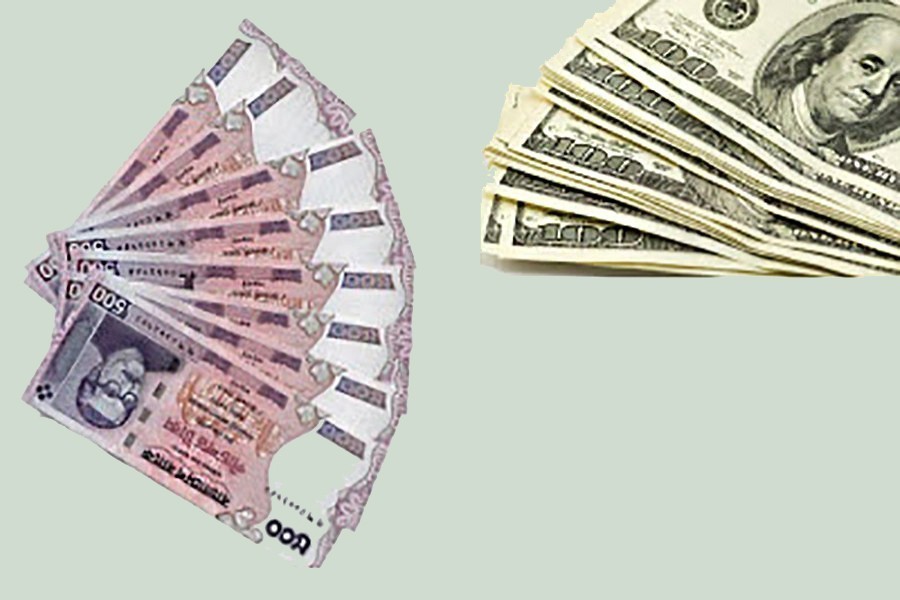Global rating agency Standard & Poor's (S&P) has considered Bangladesh's exchange rate regime as a crawl-like arrangement, though the trading mechanism was further liberalised in June 2022.
Since then, the taka's nominal exchange rate has depreciated by about 10 per cent against the US dollar, marking a notable shift in foreign exchange dynamics for Bangladesh.
"….depreciation in the currency will add to domestic inflation pressures, and make external debt servicing costs more expensive," the rating agency explained in its latest research update.
Bangladesh's external profile has weakened following a marked rise in its current account deficit driven by surging
domestic demand and higher commodity prices, according to the update.
"These trends have driven net outflows of foreign exchange from the economy, resulting in declining reserves and depreciatory pressure against the taka," the S&P said in its 10-page update.
At the same time, inward worker remittances that have long acted as a crucial support to Bangladesh's external financial flows fell in fiscal year (FY), 2021- 22, because fewer workers repatriated their assets amid a normalization in global labour markets.
Vigorous domestic demand coupled with a fast recovery in the garment sector drove Bangladesh's goods import bill to more than US$82 billion in FY'22, far higher than its previous record of around US$60 billion, and the key driver behind a surge in its current account deficit to around 4.2 per cent of GDP (gross domestic product), versus just 1.1 per cent of GDP in FY'21.
Bangladesh's economy accelerated in FY'22 and underlying momentum remains sound, the agency said, adding that the normalization of the global economy continues to drive a strong pick-up in Bangladesh's garment sector, contributing to a 12.3 per cent expansion in manufacturing activity in the outgoing fiscal year.
"The sector's recovery has also underpinned a durable recovery in the condition of Bangladesh's labour market, supporting robust domestic demand conditions," it noted.
The S&P has affirmed its 'BB-' long-term and 'B' short-term sovereign credit ratings for Bangladesh, as the country makes sound economic growth in face of heightened external pressure.
The outlook remains stable, the S&P added.
"The stable outlook reflects our expectation that Bangladesh's solid growth prospects and policy adjustments will manage the risks associated with a challenging external landscape over the next 12 months," the S&P noted.
The rating agency also said Bangladesh's economic recovery remains on a sound footing, and "we project real GDP growth to average 7.0 per year over the next three years."
Sovereign credit rating is a strong tool for positioning Bangladesh in the global financial arena by providing relevant information and related indicators about its overall economic situation, according to experts.
"Such stable rating will help both public and private sectors for getting external funds," a senior official of the Bangladesh Bank (BB) told the FE on Saturday while replying to a query.
The S&P may lower the ratings on Bangladesh if net external debt or financing metrics worsen further, such that narrow net external debt surpasses 100 per cent of current account receipts, or gross external financing needs exceed 100 per cent of current account receipts plus usable reserves, on a sustained basis.
Lower generation of current account receipts than expected, a higher overall current account deficit than predicted, or a further material decline in foreign exchange reserves would be indications of further weakening.
"We may upgrade Bangladesh if the government materially improves its fiscal outcomes, including its very low revenue generation and elevated fiscal deficits, and experiences a substantial improvement in its external settings. We may also raise the ratings if we observe that Bangladesh's institutional settings have markedly improved," it noted.
Regarding Bangladesh's banking sector, the S&P says although private sector banks are in better shape, there are notable risks in the state-owned commercial banks (SoCBs).
The SoCBs account for less than 30 per cent of total banking sector assets and their non-performing loans ratio is considerably higher than that of peer commercial banks, according to the update.


